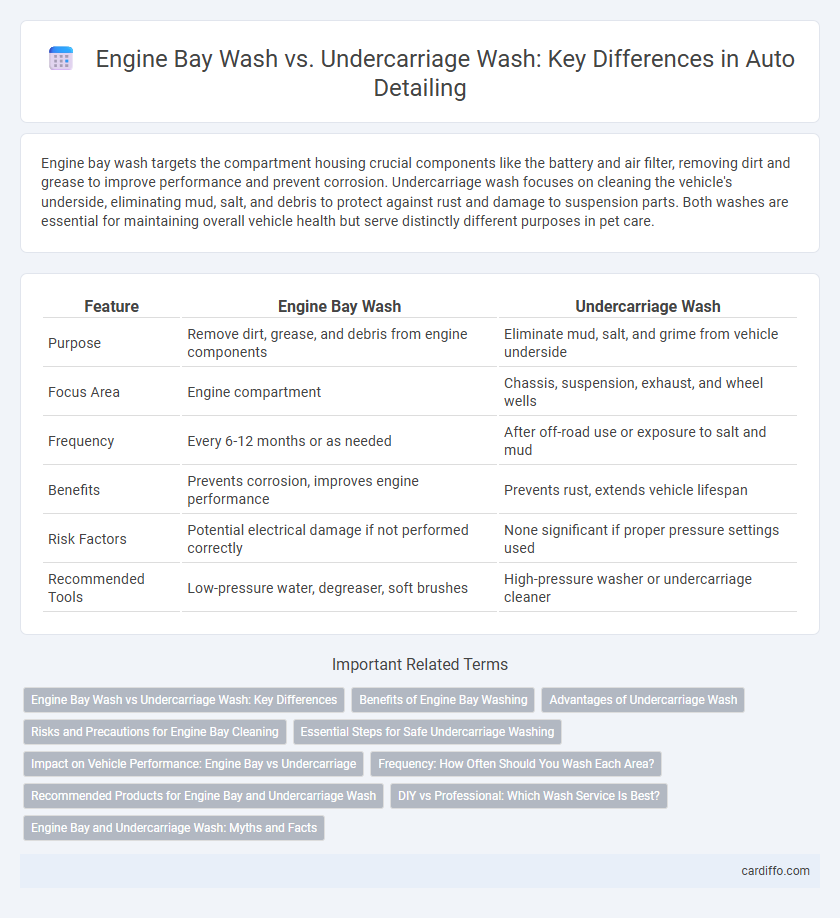Engine bay wash targets the compartment housing crucial components like the battery and air filter, removing dirt and grease to improve performance and prevent corrosion. Undercarriage wash focuses on cleaning the vehicle's underside, eliminating mud, salt, and debris to protect against rust and damage to suspension parts. Both washes are essential for maintaining overall vehicle health but serve distinctly different purposes in pet care.
Table of Comparison
| Feature | Engine Bay Wash | Undercarriage Wash |
|---|---|---|
| Purpose | Remove dirt, grease, and debris from engine components | Eliminate mud, salt, and grime from vehicle underside |
| Focus Area | Engine compartment | Chassis, suspension, exhaust, and wheel wells |
| Frequency | Every 6-12 months or as needed | After off-road use or exposure to salt and mud |
| Benefits | Prevents corrosion, improves engine performance | Prevents rust, extends vehicle lifespan |
| Risk Factors | Potential electrical damage if not performed correctly | None significant if proper pressure settings used |
| Recommended Tools | Low-pressure water, degreaser, soft brushes | High-pressure washer or undercarriage cleaner |
Engine Bay Wash vs Undercarriage Wash: Key Differences
Engine bay wash targets the compartment housing the engine, removing oil, grease, and dirt buildup that can impair performance and cause overheating, while undercarriage wash focuses on cleaning the vehicle's underside to eliminate mud, salt, and debris that contribute to rust and corrosion. Engine bay cleaning requires careful protection of electrical components and sensitive parts, whereas undercarriage washing emphasizes the removal of contaminants from suspension, braking systems, and exhaust pipes. Both washes enhance vehicle longevity but address different maintenance needs critical to optimal engine function and chassis durability.
Benefits of Engine Bay Washing
Engine bay washing improves the vehicle's performance by removing dirt, grease, and debris that can cause overheating and component damage. It enhances the longevity of engine parts, electrical connections, and hoses by preventing corrosion and buildup. Regular engine bay cleaning also aids in early detection of leaks or wear, ensuring better maintenance and safety.
Advantages of Undercarriage Wash
Undercarriage wash effectively removes dirt, salt, and debris from critical components like suspension, brakes, and exhaust systems, preventing corrosion and extending vehicle lifespan. This targeted cleaning protects against rust caused by road salt and grime accumulation that is often missed during a standard engine bay wash. Regular undercarriage washes enhance overall vehicle hygiene and performance by maintaining the integrity of parts exposed to harsh road conditions.
Risks and Precautions for Engine Bay Cleaning
Engine bay washes pose risks such as electrical component damage, corrosion, and dislodging of critical connections due to water ingress. Precautions include using low-pressure water, protecting sensitive parts with plastic covers, and ensuring the engine is cool before cleaning. Avoid harsh chemicals and always dry the area thoroughly to prevent rust and electrical failures.
Essential Steps for Safe Undercarriage Washing
Safe undercarriage washing requires using a high-pressure nozzle to remove dirt, salt, and grime from difficult-to-reach areas that can cause rust or corrosion. Properly elevating the vehicle with ramps or a lift ensures thorough cleaning while preventing accidental damage to the engine bay or suspension components. Using environmentally friendly detergent specifically designed for undercarriage use helps protect sensitive materials and maintain the vehicle's longevity.
Impact on Vehicle Performance: Engine Bay vs Undercarriage
Engine bay wash improves vehicle performance by removing dirt, grease, and debris that can cause overheating and reduce engine efficiency. Undercarriage wash prevents rust and corrosion by eliminating salt, mud, and grime buildup, which protects suspension components and enhances overall vehicle stability. Maintaining both areas ensures optimal engine function and prolongs the lifespan of critical mechanical parts.
Frequency: How Often Should You Wash Each Area?
Engine bay washes are recommended every 6 to 12 months to prevent grime buildup and maintain optimal engine performance, while undercarriage washes should be done more frequently, ideally every 1 to 3 months, especially in areas with salted roads or muddy conditions. Regular undercarriage cleaning prevents rust and corrosion by removing harmful debris and salt deposits. Tailoring the wash frequency based on driving conditions maximizes vehicle longevity and efficiency.
Recommended Products for Engine Bay and Undercarriage Wash
Recommended products for engine bay wash include degreasers with non-corrosive formulas and water-based cleaners that effectively remove oil and grime without damaging sensitive components. For undercarriage wash, heavy-duty detergents with rust inhibitors and high-pressure water sprayers help eliminate dirt, road salt, and debris while protecting metal parts from corrosion. Using specialized brushes and microfiber towels enhances cleaning efficiency and prevents scratches during both engine bay and undercarriage maintenance.
DIY vs Professional: Which Wash Service Is Best?
Engine bay wash and undercarriage wash both require different techniques and tools, making professional services more effective for thorough cleaning and avoiding damage, especially with sensitive engine components. DIY engine bay washes may risk harming electrical parts, while undercarriage washes often need high-pressure equipment to remove dirt and salt from hard-to-reach areas. Professionals use specialized cleaners and equipment that extend vehicle longevity by preventing corrosion and maintaining engine performance safely.
Engine Bay and Undercarriage Wash: Myths and Facts
Engine bay washes remove grease, dirt, and grime that can cause overheating and reduce engine efficiency while undercarriage washes target mud, salt, and debris that accelerate rust and corrosion. Myths suggest engine bay washing can damage electrical components, but using proper techniques and products prevents harm and extends engine life. Undercarriage washes are essential for maintaining suspension and brake system integrity, dispelling the misconception that they are only for aesthetic purposes.
engine bay wash vs undercarriage wash Infographic

 cardiffo.com
cardiffo.com